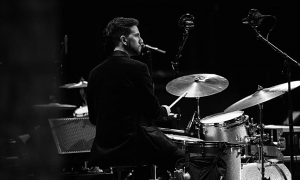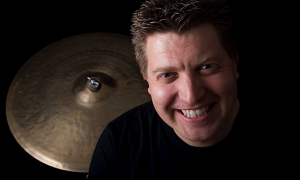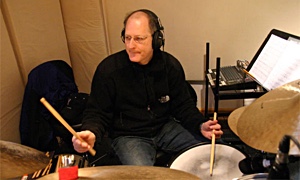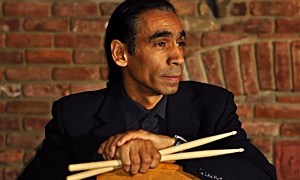Home » Jazz Articles » Rhythm In Every Guise » Vince Ector's Renewal Of The Spirit
Vince Ector's Renewal Of The Spirit
 During the course of Renewal Of The Spirit (Mambo Maniacs Records), Vince Ector's second recording as a leader, he forges a coherent, highly individualistic style of drumming from a number of disparate elements. One of the pleasures of listening to Ector on the disc's eleven tracks is discovering all of the things he brings to the music while working inside of the parameters of conventional jazz, funk, and Latin rhythms. His diverse sticking patterns, changes in dynamics, and contrasting timbres are pulled together by a fine sense of structure and organization. He also occasionally employs congas and various percussion instruments in novel ways, ranging from a few beats to several measures. Most importantly, Ector does all of these things in support of the music and never sets himself apart from the rest of the band.
During the course of Renewal Of The Spirit (Mambo Maniacs Records), Vince Ector's second recording as a leader, he forges a coherent, highly individualistic style of drumming from a number of disparate elements. One of the pleasures of listening to Ector on the disc's eleven tracks is discovering all of the things he brings to the music while working inside of the parameters of conventional jazz, funk, and Latin rhythms. His diverse sticking patterns, changes in dynamics, and contrasting timbres are pulled together by a fine sense of structure and organization. He also occasionally employs congas and various percussion instruments in novel ways, ranging from a few beats to several measures. Most importantly, Ector does all of these things in support of the music and never sets himself apart from the rest of the band.Taken at a brisk tempo, "Rooftop, the disc's swinging opening track, is a good introduction to Ector's modus operandi. On the head of tenor saxophonist Jay Collins' composition, he's quite assertive. The snare, tom-toms, and bass drum produce a hard, unyielding, metallic sound. At the onset of Collins' solo, Ector does an about face, and the dry ping of the ride cymbal becomes the most prominent part of his drum kit. Throughout Collins' three choruses and two by pianist John diMartino, he's an accompanist rather than an interactive force. Without ever really calling any attention to his drumming, Ector introduces something new and different on nearly every chorus. Aside from some unobtrusive snare and bass drum comping, he varies the emphasis of the ride cymbal, plays a riff-like pattern on the bass drum in conjunction with a series of light cymbal crashes, works some bracing snare drum accents around diMartino's jabbing chords and, for several bars, strikes a neat balance between the cymbal, hi-hat on beats two and four, and the solid click of a rim knock on beat four.
A piano, bass, and drums trio interprets Antonio Carlos Jobim's "Luiza as a pensive ballad in ¾ time. Playing mostly simple quarter and eighth note rhythms at a low volume, Ector is expressive in a patient way, creating a firm yet restrained pulse, and providing color by using sticks, brushes and mallets. His execution is flawless. Beginning with light strokes to a cymbal on the first beat of every measure, each of which sounds a little different, he slowly builds as the sections of the song unfold. In the early stages, Ector's strokes are often more felt than heard, and at times his volume is so low that it's difficult to tell whether he's using sticks or brushes. In support of diMartino's interpretation of the melody and solo he frequently employs rim knocks on all three beats. Ector also keeps adding little touches that make a difference—like lightly scraping a brush across the drum head; using the hi-hat pedal to make a smart snap or a light swoosh; or tapping the bass drum in a familiar pattern during bassist Leon Lee Dorsey's bowed solo.
Ector's invigorating shuffle beat is the heart and soul of a performance of his composition "Moving On. During an eight measure introduction consisting of a repeated two-bar vamp played by diMartino and Dorsey, he sets the pace by emphasizing a few elements: Resounding cymbal crashes placed on downbeats; a crackling, repetitious shuffle pattern applied to the snare; and a similar pattern on the bass drum played at a lower volume so that it sounds like an echo of the snare. Both disciplined and outgoing, his drums and cymbals really make the band jump. Throughout the twice repeated fourteen bar head, while Dan Faulk plays the melody, Ector continues with the snare pattern, puts more emphasis on the ride cymbal, and adds stout fills to the snare and toms that briefly offset the shuffle's rigid design. He strays even further during the second chorus of Faulk's solo. Sensing that the tenor saxophonist is about to reach a climax, Ector obsessively hammers eighth note triplets with both sticks, then makes irregular, sputtering hits to the bass drum and cymbal. The effect is electrifying, temporarily ratcheting up the band's energy level before Ector resumes the shuffle.
 Ector plays only the cymbals for nearly the entire first chorus of diMartino's solo on the pianist's "Remembrance. His playing walks a fine line between support of diMartino and a semi-autonomous rhythmic line. He doesn't continuously ride one cymbal, yet there's genuine momentum and continuity in his playing. He stays at a fairly low dynamic level throughout, so his rhythms never really stand out. Just when you begin to perceive a specific pattern, Ector is on to something else. Occasionally he'll play a complete, recognizable phrase, but doesn't immediately repeat or build on it. Instead there's an element of familiarity in the way he offers pieces of a few patterns in different places at various times. Ector strikes the cymbals in many ways, including hitting two at the same time, or making 3 or 4 stroke combinations with two sticks. He also utilizes the hi-hat pedal to get a terse, chomping sound and a thickset crash. In a different way than "Moving On, it's a highly disciplined performance that never detracts from the evolution of diMartino's solo.
Ector plays only the cymbals for nearly the entire first chorus of diMartino's solo on the pianist's "Remembrance. His playing walks a fine line between support of diMartino and a semi-autonomous rhythmic line. He doesn't continuously ride one cymbal, yet there's genuine momentum and continuity in his playing. He stays at a fairly low dynamic level throughout, so his rhythms never really stand out. Just when you begin to perceive a specific pattern, Ector is on to something else. Occasionally he'll play a complete, recognizable phrase, but doesn't immediately repeat or build on it. Instead there's an element of familiarity in the way he offers pieces of a few patterns in different places at various times. Ector strikes the cymbals in many ways, including hitting two at the same time, or making 3 or 4 stroke combinations with two sticks. He also utilizes the hi-hat pedal to get a terse, chomping sound and a thickset crash. In a different way than "Moving On, it's a highly disciplined performance that never detracts from the evolution of diMartino's solo.
Aside from his timekeeping and accompaniment, Ector plays several solos on the record as well. Displaying excellent sticking technique and a logical progression of ideas, his twenty-four bar break on "Melly's Blues is one long burst of agitated movement. Devoid of a steady ride cymbal or constant bass drum, he nonetheless moves the solo along in a continuous, linear fashion. His drums sound large and imposing, yet there's never any dead weight. The snare drum is the focal point, and the dense, persistent bunches of strokes are broken up by brief jabbing forays to the tom toms.
Unlike the highly disciplined shuffle that drives the band for most of the track, Ector's sixty-bar "Moving On solo is skittish and wildly imaginative. For the most part he plays forceful brush strokes over diMartino's rock hard vamp. Sometimes he's tethered to the vamp; in other instances he flies in the face of it. Ector explores every nook and cranny of the phrase, approaching it from any number of angles. He jams dozens of rowdily flapping strokes into a few bars, or simply makes a few select hits. An anti-climactic ending consists of Ector steadily rubbing the brush across the drum head at a volume way below diMartino's piano.
< Previous
Neighbourhood
Comments
Tags
Concerts
For the Love of Jazz
 All About Jazz has been a pillar of jazz since 1995, championing it as an art form and, more importantly, supporting the musicians who create it. Our enduring commitment has made "AAJ" one of the most culturally important websites of its kind, read by hundreds of thousands of fans, musicians and industry figures every month.
All About Jazz has been a pillar of jazz since 1995, championing it as an art form and, more importantly, supporting the musicians who create it. Our enduring commitment has made "AAJ" one of the most culturally important websites of its kind, read by hundreds of thousands of fans, musicians and industry figures every month.
























